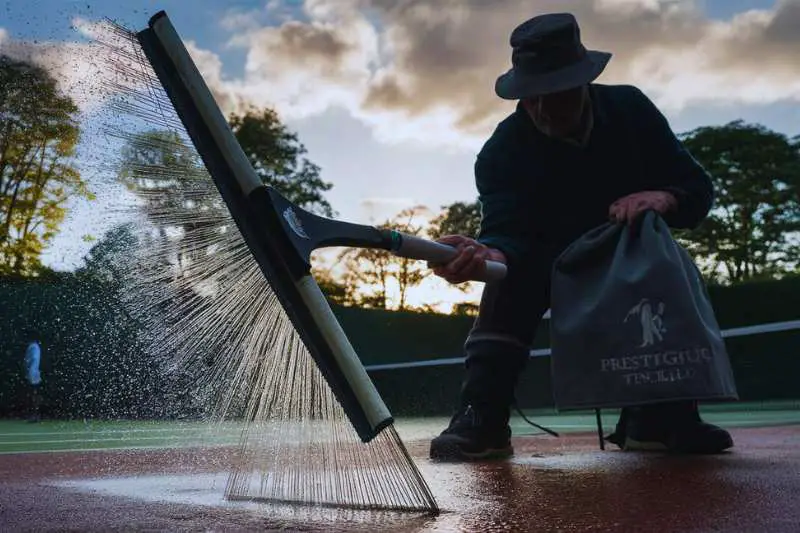Tennis courts typically take 1-2 hours to dry after a rain. The exact time can vary based on weather conditions and court materials.
Tennis players know that court conditions are important for a good game. Understanding the drying time of tennis courts is essential, especially for those who manage or maintain these facilities. Quick-drying surfaces allow for resuming play as soon as possible, minimizing disruption and maximizing court usage.
Different types of courts, such as grass, clay, or hard surfaces, have varying drying times and require specific maintenance procedures. Proper drainage systems and squeegees can expedite the process, ensuring the courts are ready for action without compromising safety or play quality. Coaches, players, and sports facility managers should be aware of these aspects to effectively schedule matches and practice sessions.
Factors Affecting Drying Time
The drying time of tennis courts varies greatly. This depends on two main factors. Type of tennis court surface and weather conditions are key. For example, clay courts dry slower than hard courts. This is because water drains more easily through hard materials. On a sunny and windy day, courts dry faster. Rainy or humid conditions slow down the process. Each court and day is different. So, drying times can change a lot.
The Role Of Sunlight And Temperature
The intensity of sunlight plays an important role in drying tennis courts. Direct sunlight speeds up the drying process significantly. Courts dry faster on clear, sunny days compared to cloudy ones. Ambient temperature also impacts drying time. Higher temperatures help evaporate moisture quicker. Yet, even on warm days, a light air can further enhance drying. Together, sunlight and temperature determine how long you wait to play.
Humidity And Air Flow
Humidity levels greatly affect tennis court drying times. High humidity can slow down the evaporation of moisture. This results in longer drying periods for courts. Conversely, low humidity can speed up the process, leading to quicker playability.
Air circulation is important in reducing drying time. Proper ventilation helps moisture evaporate faster. This is why outdoor courts often dry quicker than indoor courts. Fans or natural breezes are beneficial in promoting efficient drying.
Water Management Techniques
Proper water management is key for tennis courts to dry efficiently. A well-designed surface slope ensures water flows off quickly. This minimizes downtime after rain. Drainage systems are crucial in this process. They help remove water from the court surface.
Squeegees and blowers are effective tools for drying courts. They manually push water off the playing surface. This method speeds up the drying time significantly. Courts become playable sooner, delighting players.

Average Drying Times
Tennis courts vary in drying times based on their surface type. Clay courts often dry quicker than hard courts. Grass courts need sunshine to dry effectively.
Real-life examples show that clay courts can dry in under an hour with good conditions. Hard courts might take up to 2 hours to dry after rain. Yet, grass courts take the longest, sometimes needing a full day of sunlight.
Speeding Up The Drying Process
Drying tennis courts quickly is important for players and maintenance teams. Advanced drying methods and preventive measures can help. Using high-powered blowers speeds up the process. Blowers push water off the surface fast. Water-absorbing materials, like sponges, also play a key role. They soak up moisture efficiently.
Preventive steps are vital too. Applying water-repellent coatings to the court surface prevents water from soaking in. This means less drying time is needed after rain. Scheduling regular maintenance ensures coatings are always effective.

Frequently Asked Questions
How Fast Do Tennis Courts Dry Up?
Tennis courts typically dry within 1 to 2 hours after rain, depending on the surface type, wind conditions, and ambient temperature. Acrylic hard courts dry faster than clay or grass courts.
Can You Play Tennis On Wet Courts?
Playing tennis on wet courts is not recommended as it can be dangerous and damage the court surface. It’s best to wait until the courts dry.
How Long Does It Take For Tennis Court Paint To Dry?
Tennis court paint typically dries within 24 to 48 hours under optimal weather conditions. Factors like humidity and temperature can affect drying time.
How To Dry A Wet Tennis Court?
To dry a wet tennis court, use a court squeegee or roller to remove standing water. Absorbent materials like towels can also help. For quicker drying, employ air blowers or fans, and always ensure good drainage to prevent future water accumulation.
What Factors Affect Tennis Court Drying Time?
Drying times for tennis courts can vary due to factors such as surface material, temperature, humidity, and wind conditions.
Conclusion
Drying times for tennis courts vary due to several factors, including material and weather conditions. Understanding these aspects can help players and facilities plan effectively. Remember, patience is key for a safe and optimum playing surface. Consult with experts for tailored maintenance advice to ensure your court remains in top condition year-round.


